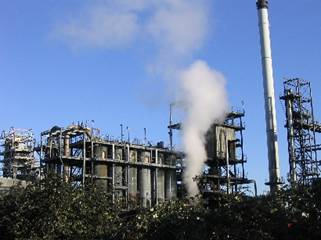How do externalities affect allocative efficiency?
 Given the existence of perfect competition, allocative efficiency would automatically occur where price equals marginal cost in all markets, assuming that neither negative nor positive externalities are present.
Given the existence of perfect competition, allocative efficiency would automatically occur where price equals marginal cost in all markets, assuming that neither negative nor positive externalities are present.
So, how do externalities affect our condition for efficiency? Let's consider case of a firm which discharges its waste products into a river. Such a firm would be treating the environment as a free resource, and would be imposing a cost on society as a whole, rather than just on the consumers of the good. The price charged to consumers would not therefore, in this instance, reflect the true cost of the product; if the firm were compelled to install equipment which could treat its effluent and render it harmless to the environment, its production costs and prices would rise and consumers would, as a consequence, reduce their demand for the product in question. Resources would then be reallocated to other lines of production.
In this case there is a divergence between private and social cost.
- The private cost is the internal money cost of production incurred by the firm i.e. costs such as wages, raw materials, heating and lighting that must be paid to carry out production, and which would appear in the firm's accounts.
- The social cost, on the other hand, is the real cost to society as a whole; it is the private, internal costs plus the value of the negative externalities (external costs).
Similarly, if the firm's production decisions were to generate positive externalities, such as the beneficial effects arising from the provision of employment, then there would be a divergence between private and social benefit.
- The private benefit is the money value of the benefits accruing internally to the firm from production activity e.g. in the form of sales revenues.
- The social benefit, on the other hand, is the private benefit plus the value of positive externalities (external benefits).

Social cost
Social cost is the private, internal cost plus the value of negative externalities.

Social benefit
Social benefit is the private, internal benefits plus the value of positive externalities.
Now, the significance of this analysis is that allocative inefficiency will occur if private cost or benefit diverges from social cost or benefit. Where externalities exist the condition for allocative efficiency is that price = social marginal cost = social marginal benefit i.e. the price must equal the true marginal cost of production to society as a whole, rather than just the private marginal cost.
We will now illustrate the above in relation to the firm discharging waste into the river.
Hence externalities cause market failure:
- when a negative production externality is initiated, the firm will not be made to pay for the cost imposed on others, and will therefore have no market incentive to produce less; from society's standpoint it will therefore overproduce;
- when a positive externality arises, the firm will lack any incentive to increase its output to the socially desirable level, as it does not receive any payment for the generation of the external benefit; underproduction therefore occurs.
